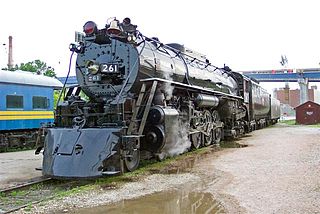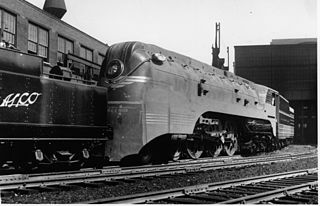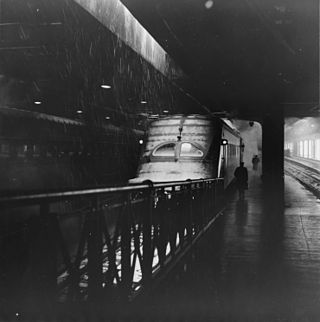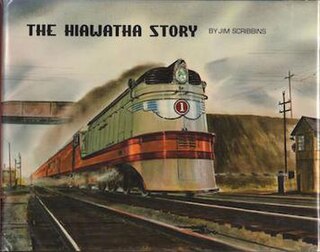
Under the Whyte notation for the classification of locomotives, 4-6-4 represents the wheel arrangement of four leading wheels, six powered and coupled driving wheels and four trailing wheels. In France where the type was first used, it is known as the Baltic while it became known as the Hudson in most of North America.

A streamliner is a vehicle incorporating streamlining in a shape providing reduced air resistance. The term is applied to high-speed railway trainsets of the 1930s to 1950s, and to their successor "bullet trains". Less commonly, the term is applied to fully faired upright and recumbent bicycles. As part of the Streamline Moderne trend, the term was applied to passenger cars, trucks, and other types of light-, medium-, or heavy-duty vehicles, but now vehicle streamlining is so prevalent that it is not an outstanding characteristic. In land speed racing, it is a term applied to the long, slender, custom built, high-speed vehicles with enclosed wheels.

Milwaukee Road 261 is a class "S3" 4-8-4 "Northern" type steam locomotive built by the American Locomotive Company (ALCO) in Schenectady, New York in July 1944 for the Milwaukee Road (MILW). It was used for heavy mainline freight and passenger work until being retired by the MILW in 1956.

Saint Paul Union Depot is a historic railroad station and intermodal transit hub in the Lowertown neighborhood of Saint Paul, Minnesota. It serves light rail, intercity rail, intercity bus, and local bus services.

The Hiawathas were a fleet of named passenger trains operated by the Chicago, Milwaukee, St. Paul and Pacific Railroad between Chicago and various destinations in the Midwest and Western United States. The most notable of these trains was the original Twin Cities Hiawatha, which served the Twin Cities in Minnesota. The train was named for the epic poem The Song of Hiawatha by Henry Wadsworth Longfellow. The current Amtrak Hiawatha train is directly descended from the Milwaukee Road trains.

The Chicago and North Western was a Class I railroad in the Midwestern United States. It was also known as the "North Western". The railroad operated more than 5,000 miles (8,000 km) of track at the turn of the 20th century, and over 12,000 miles (19,000 km) of track in seven states before retrenchment in the late 1970s. Until 1972, when the employees purchased the company, it was named the Chicago and North Western Railway.

Under the Whyte notation for the classification of steam locomotives by wheel arrangement, 4-4-2 represents a configuration of a four-wheeled leading bogie, four powered and coupled driving wheels, and two trailing wheels supporting part of the weight of the boiler and firebox. This allows a larger firebox and boiler than the 4-4-0 configuration.

The Iowa, Chicago and Eastern Railroad (IC&E) was a Class II railroad operating in the north central United States. It has been controlled by the Canadian Pacific Railway and operated as a part of its system since October 30, 2008. Formerly, the IC&E was jointly owned with the Dakota, Minnesota and Eastern Railroad by Cedar American Rail Holdings (CARH), making the combined system the largest class II railroad in the United States. Created by the purchase of I&M Rail Link, IC&E commenced operations on July 30, 2002. The 1,400-mile (2,300 km) line, based in Davenport, Iowa, serves the states of Illinois, Iowa, Missouri, Minnesota and Wisconsin. Principal commodities include chemicals, coal, steel, automobiles, and agricultural products. Train dispatching is performed at a joint DM&E/IC&E facility in Sioux Falls, South Dakota. On December 26, 2008, the IC&E was merged into parent CARH, which immediately merged into the DM&E.

The 400 was a named passenger train operated by the Chicago and North Western Railway between Chicago and Saint Paul, with a final stop in Minneapolis. The train took its name from the schedule of 400 miles between the cities in 400 minutes, and was also a nod to "The Four Hundred Club", a term coined by Ward McAllister to refer to the social elite of New York City in the late 19th century. It was an express train with limited stops between Chicago and the Twin Cities. The "400" ran from 1935 to 1963 on the Chicago to Twin Cities route. The C&NW later named their other passenger trains using the number "400".

The Chicago, Milwaukee, St. Paul and Pacific Railroad classes EP-1 and EF-1 comprised 42 boxcab electric locomotives built by the American Locomotive Company (Alco) in 1915. Electrical components were from General Electric. The locomotives were composed of two half-units semi-permanently coupled back-to-back, and numbered as one unit with 'A' and 'B' suffixes. As built, 30 locomotives were assigned to freight service, classified as EF-1 and numbered 10200–10229. The remaining twelve locomotives were assigned to passenger service as class EP-1, numbered 10100–10111, with higher-speed passenger gearing. The design was highly successful, replacing a much larger number of steam locomotives, cutting costs and improving schedules. General Electric self-proclaimed this electric locomotive to be the “King of the Rails” in a silent promotional film from 1915.

The Milwaukee Road Class "A" was a class of high-speed, streamlined 4-4-2 "Atlantic" type steam locomotives built by the American Locomotive Company (ALCO) from 1935 to 1937 to haul the Milwaukee Road's Hiawatha express passenger trains. Numbered from No. 1 to No. 4, they were among the last Atlantic type locomotives built in the United States, and certainly the largest and most powerful. The class were the first locomotives in the world built for daily operation at over 100 mph (160 km/h), and the first class built completely streamlined, bearing their casings their entire lives. Although partially supplanted by the larger class "F7" Hudsons from 1937, they remained in top-flight service until the end. Locomotive No. 3 was taken out of service in 1949 and cannibalized for spare parts to keep the other three running until 1951.

The Milwaukee Road's class "F7" comprised six (#100–#105) high-speed, streamlined 4-6-4 "Baltic" (Hudson) type steam locomotives built by the American Locomotive Company (ALCO) in 1937–38 to haul the Milwaukee's Hiawatha express passenger trains. Following on from the success of the road's class "A" 4-4-2s, the F7s allowed the road to haul heavier trains on the popular Chicago–Twin Cities routes.

The Chicago and North Western Class E-4 was a class of nine streamlined 4-6-4 "Hudson" steam locomotives built in 1937 by the American Locomotive Company (ALCO).

The Milwaukee Road classes F6 and F6-a comprised twenty-two steam locomotives of the 4-6-4 configuration, commonly nicknamed “Hudson” but known as “Baltic” on the Milwaukee Road.

The Twin Zephyrs, also known as the Twin Cities Zephyrs, were a pair of streamlined passenger trains on the Chicago, Burlington and Quincy Railroad (CB&Q), running between Chicago and the Twin Cities of Minneapolis and Saint Paul in Minnesota. It was the second Zephyr service introduced by CB&Q after the record-setting Denver–Chicago "dawn to dusk dash" of the Pioneer Zephyr trainset.

The Twin Cities Hiawatha, often just Hiawatha, was a named passenger train operated by the Chicago, Milwaukee, St. Paul and Pacific Railroad, and traveled from Chicago to the Twin Cities. The original train takes its name from the epic poem The Song of Hiawatha by Henry Wadsworth Longfellow. There are a number of Hiawatha-themed names within the city of Minneapolis, the terminus of the original train. The first Hiawatha ran in 1935; in 1939 the Milwaukee Road introduced a second daily trip between Chicago and Minneapolis. The two trains were known as the Morning Hiawatha and Afternoon Hiawatha, or sometimes the AM Twin Cities Hiawatha and PM Twin Cities Hiawatha. The Milwaukee Road discontinued the Afternoon Hiawatha in 1970 while the Morning Hiawatha continued running until the formation of Amtrak in 1971.

The Minnesota 400 was a streamlined passenger train operated by the Chicago and North Western Railway on its southern Minnesota line between Mankato, Minnesota and Wyeville, Wisconsin. It began running in 1936. In 1950 it was extended to run between Chicago, Illinois and Huron, South Dakota and renamed the Dakota 400. It would be further extended to Rapid City, South Dakota, before being cut back to Mankato, in 1960. This final iteration was named the Rochester 400 and it ceased operation in 1963.

The North Woods Hiawatha was a streamlined passenger train operated by the Chicago, Milwaukee, St. Paul and Pacific Railroad between New Lisbon and Minocqua, Wisconsin. It operated from 1936 until 1956. The North Woods Hiawatha was the first new route to adopt the Hiawatha brand.

The Hiawatha Story is a 1970 non-fiction book on railroad history by Jim Scribbins, then an employee of the Chicago, Milwaukee, St. Paul and Pacific Railroad. The book covers the history of the Milwaukee Road's most famous passenger train, the Hiawatha, from its creation in 1934–1935 up through 1970. The book also covered the various other Milwaukee Road trains which carried the name "Hiawatha."


















